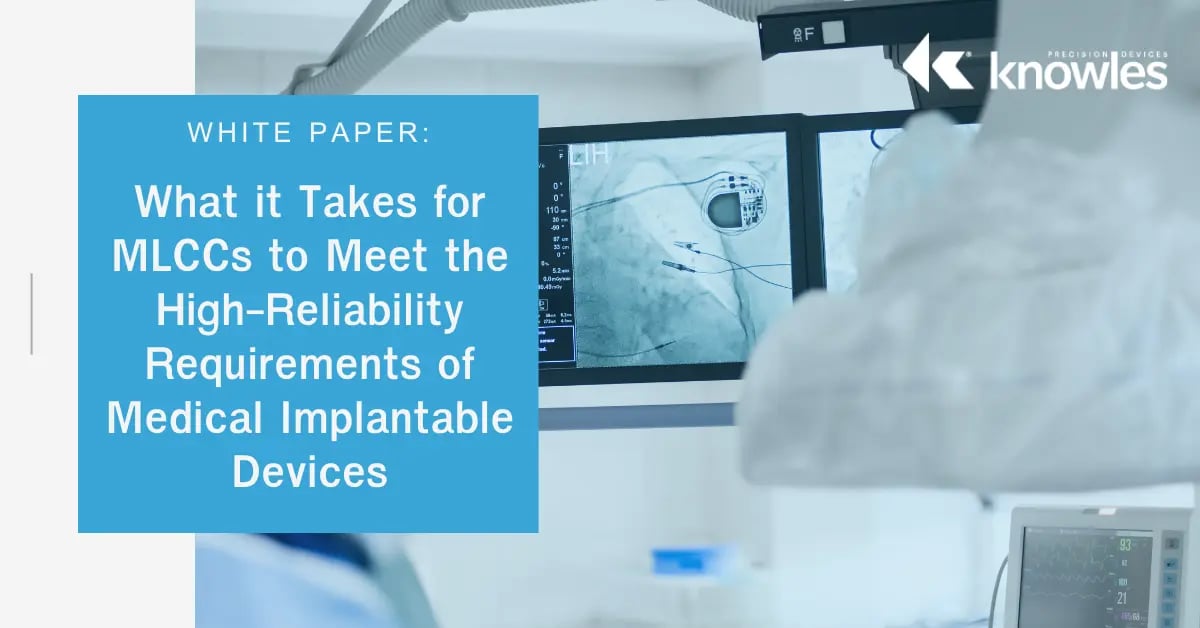Designing medical implantable devices for high reliability is crucial for a variety of reasons. First, given the life-critical functions performed by many medial implantable devices, and the invasive procedure required to implant medical equipment properly in the human body, it is imperative that all medical devices are designed to function reliably throughout their entire lifetime. Furthermore, since patient safety is paramount, any precautions to reduce the possibility of potentially life-threatening malfunctions, recalls, and replacement surgeries are necessary. And, beyond preventing patient safety issues, there may also be severe economic and legal implications for device manufacturers if an implantable device fails.

But, ensuring the reliability of medical implantable devices is not straightforward since these devices are typically made up of many individual parts, including a variety of electronic components such as multi-layer ceramic capacitors (MLCCs). For medical device designers, there are a lot of decisions to make when selecting MLCCs. Some of the more standard considerations include case size, voltage and capacitance rating, and dielectric selection to ensure management of operating temperatures and temperature coefficients.
In addition to these fairly typical considerations, ensuring the MLCCs are designed for high reliability is also critical. While high reliability may sound like a subjective term, in the medical industry, high reliability has a specific meaning – the component is designed to maintain consistent excellence in quality and safety over long periods of time.
So, How Can You Ensure MLCC Reliability?
The short answer is proper testing and screening. More specifically, for MLCC testing, every high-reliability (Hi-Rel) capacitor should be 100 percent electrically inspected and burned-in at elevated voltage and temperature levels to precondition the parts and comply with the established performance criteria. Additionally, voltage conditioning testing acts as an accelerated test to ensure the functionality and longevity of the part, alongside eliminating infant mortalities due to manufacturing imperfections that are not identified with standard industry testing.
Beyond these tests, when establishing high reliability for MLCCs for medical implantable devices specifically, parts must be screened using an established method. In general, screening means that a series of tests and inspections at the parts level are performed to remove nonconforming and/or infant mortal parts, increasing confidence in the parts selected. For medical implantable devices, screening is generally performed by following these two long-standing military specifications (MIL-SPECS) for reliability – MIL-PRF-55681 (Group A) and MIL-123 (Group A).
As a medical device designer, it’s important to have a general understanding of MIL-SPECs and the parts screening process before deciding on the medical implantable-grade MLCCs that are right for your device. By having this level of understanding, you can better discuss your needs with potential suppliers. At Knowles Precision Devices, we are well-qualified to help customers select and screen MLCCs for medical implantable devices as we have more than 40 years’ experience serving customers in the Hi-Rel implantable medical device market.
To learn more about MLCC screening and how Knowles Precision Devices can help ensure your implantable medical devices are designed for high reliability, download our latest white paper, What it Takes for MLCCs to Meet the High-Reliability Requirements of Medical Implantable Devices.


